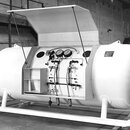Maybe the next generation of dive computers will interface with hyperbaric chambers. It’s kind of interesting you need a trained doctor to run a chamber, but can use a $120 computer to “prescribe” a decompression ascent.
Yeah, but the computer isn't going to know what to do if you start to tox or your stomach starts hurting or your toes go numb, or your vision gets blurry or ... or... or....
It's like teaching scuba diving. Most any diver could probably teach someone else how the basics. The problem is the "teacher" knowing (or not) how to handle any of the vast array of problems that COULD happen during the process.





